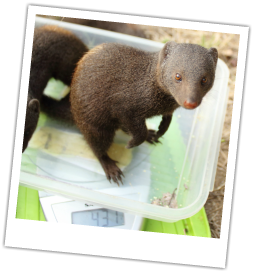
The Dwarf Mongoose Research Project was established on Sorabi Rock Lodge Reserve by Julie Kern in 2011, to investigate a free-living population of cooperatively breeding dwarf mongooses in South Africa.
We are currently collecting data from 8 groups (group size 5-17) habituated to the presence of human observers on foot, with work continually ongoing to bring more groups into the population. All animals within the habituated population are individually identifiable through small blonde dye marks on their fur and are accustomed to being weighed daily, freely climbing into an electronic balance.
Supported by the University of Bristol, UK, and the University of Pretoria, South Africa, our research explores the interactions of animals in social groups, with particular emphasis on the use of communication to coordinate cooperative behaviour and to mediate conflict within and between groups.
Current research topics include: the behavioural, hormonal and reproductive consequences of out-group conflict; the impacts of anthropogenic noise on communication and information use; interspecific eavesdropping; social networks and the benefits of 'friendships'; information reliability and behavioural flexibility; and sentinel behaviour.
We are currently collecting data from 8 groups (group size 5-17) habituated to the presence of human observers on foot, with work continually ongoing to bring more groups into the population. All animals within the habituated population are individually identifiable through small blonde dye marks on their fur and are accustomed to being weighed daily, freely climbing into an electronic balance.
Supported by the University of Bristol, UK, and the University of Pretoria, South Africa, our research explores the interactions of animals in social groups, with particular emphasis on the use of communication to coordinate cooperative behaviour and to mediate conflict within and between groups.
Current research topics include: the behavioural, hormonal and reproductive consequences of out-group conflict; the impacts of anthropogenic noise on communication and information use; interspecific eavesdropping; social networks and the benefits of 'friendships'; information reliability and behavioural flexibility; and sentinel behaviour.

